An urban Adelaide garden
In an Adelaide tree-lined suburb is a large family home and garden, largely hidden from the street by a hedge of Pittosporum and Photinia, one of the few remaining features from the old garden. The house underwent major renovations and the associated destruction, coupled with the changing water restrictions, dictated a major garden overhaul with a new master plan. An emphasis in this new design was the seamless transition between the indoors and outdoors.
The garden has an inspired mix of Australian natives, Mediterranean exotics and productive plants, which relate to the mood and functions of the 110-year-old sandstone villa. The plants have been selected for their drought resistance, low water requirements and biodiversity merit in attracting birds and butterflies.
The garden was planted two years ago and one of the biggest challenges was selecting plants that would perform with the fierce competition of the 100-year-old London plane street trees with their extensive root system. The ever-tough Euphorbia bourgeana (syn. E. lambii) and Romneya coulteri are now doing well alongside the front hedge, which gives height and structure.
At the rear of the garden is the vegetable garden and working area where waste garden material is shredded and composted to make humus-rich soil. The garden is heavily mulched and a drip irrigation system, using rainwater from three tanks, makes the most of the natural rainfall.
The garden is divided into sections.
Driveway Garden
The hero plant is the large Lemon-Scented Gum. Its trunk and bark turn a deep salmon colour before peeling back to reveal a silvery layer each summer. This tree dictated the need for a predominantly Australian-themed planting to reflect the arid mallee country with grey- and silver-foliaged plants. In particular Eucalyptus gillii, Leucophyta brownii (syn. Calocephalus brownii) and Eremophila glabra (prostrate form). Another contemporary trend is the use of tightly clipped Australian plants, Westringia fruticosa ‘Jervis Gem’ and Eremophila maculata, as well as Teucrium fruticans.
Front Garden
This formally arranged garden showcases a diverse range of hardy plants. Syzygium hedges (Native Lillypilly) divide the front garden into sections for more informal planting and clipped Buxus microphylla (syn. B. japonica) provides accent points along the paths. Freer and more floriferous plants fill out the spaces in between and provide seasonal variation, including Agastache (Hummingbird Mints), Cistus, Romneya and euphorbias.
From the front garden a narrow winding path leads one around the side of the house. Clematis terniflora (syn. C. maximowicziana), Clivia miniata and Brugmansia x candida are featured here with the ‘four seasons’ statuettes.
The Pool Garden
The garden around the kitchen and pool was designed to create a sense of leafy paradise. The true stars of the planting scheme are the Abyssinian Bananas whose vibrant green leaves uncurl to reveal a spectacular pink-red central vein. Other tougher Australian plants such as Doryanthes (Gymea Lily) and Lomandra longifolia ‘Tanika’ were used for their vibrant green and lush appearance. The shaggy Acacia cognata standards with their lime-green foliage rise out of the swathe of Lomandra grasses which create the sense of an oasis. Twice a year this green garden takes on a whole new colour dimension. In early spring the Echium ‘Cobalt Towers’ sends up blue spires that hum with honeybees and in late spring the jacaranda tree puts on a spectacular show of purple bells.
Gravel Garden
Near the rear of the house is a high-profile area planted with ‘favourites’ in gravel mulch: Dracaena draco (Dragon Tree), Limonium perezii and Euphorbia rigida.
Cycads are also featured such as Zamia furfuracea (Cardboard Palm), Lepidozamia peroffskyana and Cycas revoluta.
Productive Garden
In the rear garden are six raised vegetable beds made from recycled red gum sleepers. A seasonal rotational system ensures year-round peak performance.
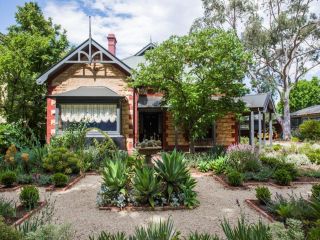
Toxicodendron succedaneum (syn. Rhus succedanea), centrepiece
of Agave attenuata, Cotyledon ‘Silver Waves’ and echeveria.
Teucrium betonicum, Buddleja davidii ‘Black Night’ and
Euphorbia characias ssp. wulfenii in main garden beds
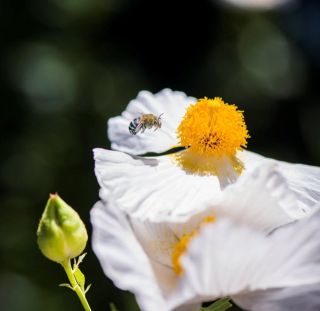
Papier-mâché-like flower of Romneya coulteri attracting a bee
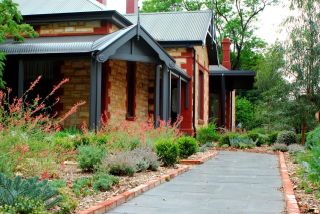
Summer show of Agastache aurantiaca (orange hummingbird mint),
Teucrium marum, Euphorbia rigida and Eucalyptus scoparia in the background
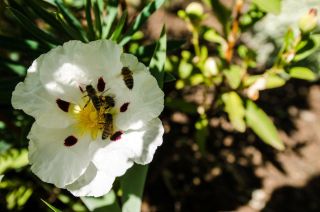
Cistus x purpureus swarming with bees
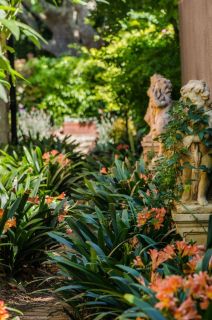
Clivia miniata and Clematis terniflora (syn. C. maximowicziana)
draping over a four seasons statuette
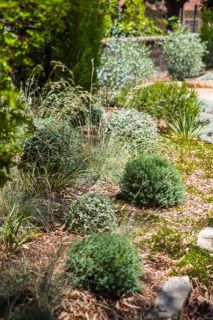
Clipped balls of Westringia fruticosa ‘Jervis Gem’,
Eremophila maculata and Teucrium fruticans punctuated
with Cymbopogon ambiguus (lemon-scented grass)
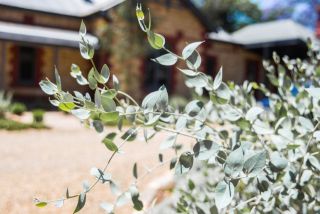
Eucalyptus gillii in the Australian garden with its beautiful
rounded silver leaves. My favourite foliage plant, ideal for picking
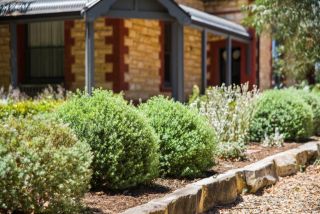
Clipped balls of Westringia fruticosa ‘Jervis Gem’
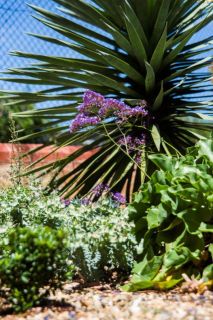
Dracaena drago (dragontree), Limonium perezii
and Euphorbia rigida, a splendid combination
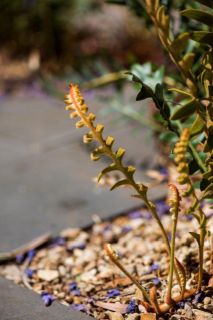
New growth of Banksia blechnifolia
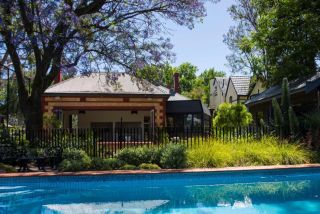
Jacaranda treein full summer bloom with the green oasis of
Lomandra longifolia ‘Tanika’ and Acacia cognata grown as standards,
spires of Echium ‘Cobalt Towers’ and a hedgeof Teucrium heterophyllum
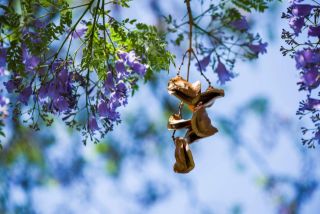
Jacaranda flowerin summer showcasing its beautiful seedpod
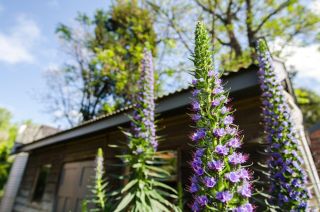
Spires of Echium ‘Cobalt Towers’attract the honeybees
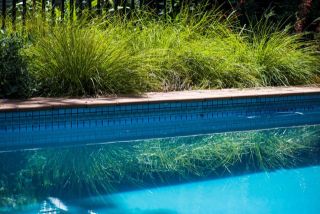
Reflection of Lomandra longifolia ‘Tanika’in the swimming pool
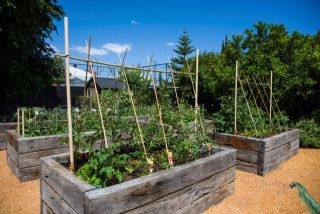
Raised red gum sleeper vegetable garden with summer planting of
tomatoes, lettuce, aubergines and capsicums
|


